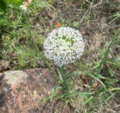Allium canadense
-
Allium canadense var. canadense
-
Allium canadense var. hyacinthoides
Allium canadense[edit]
Allium canadense, commonly known as the wild onion or Canada onion, is a perennial plant native to North America. It belongs to the Amaryllidaceae family, which includes other species such as Allium cepa (the common onion) and Allium sativum (garlic).
Description[edit]
Allium canadense is a herbaceous plant that typically grows to a height of 30 to 50 centimeters. The plant has a bulbous base, from which a single flowering stalk emerges. The leaves are long, narrow, and grass-like, growing from the base of the plant. The flowers are arranged in an umbel at the top of the stalk and are usually white or pink in color. Each flower has six tepals and six stamens.
Habitat[edit]
This species is commonly found in a variety of habitats, including meadows, prairies, and open woodlands. It prefers well-drained soils and can often be found in areas that receive full to partial sunlight. Allium canadense is native to a wide range of regions in North America, from Canada to the southern United States.
Ecology[edit]
Allium canadense plays a role in its ecosystem by providing food for various pollinators, including bees and butterflies. The plant's bulbs are also consumed by some wildlife, such as small mammals. Additionally, the plant can form dense colonies, which can help stabilize soil and prevent erosion.
Uses[edit]
Historically, Allium canadense has been used by indigenous peoples for both culinary and medicinal purposes. The bulbs and leaves can be eaten raw or cooked, and they have a flavor similar to that of cultivated onions. Medicinally, the plant has been used to treat a variety of ailments, although such uses are less common today.
Cultivation[edit]
Allium canadense can be cultivated in gardens, where it is valued for its ornamental flowers and its ability to attract pollinators. It is relatively easy to grow, requiring minimal maintenance once established. The plant can be propagated by dividing the bulbs or by sowing seeds.
Related pages[edit]
Ad. Transform your life with W8MD's Budget GLP-1 injections from $75


W8MD offers a medical weight loss program to lose weight in Philadelphia. Our physician-supervised medical weight loss provides:
- Weight loss injections in NYC (generic and brand names):
- Zepbound / Mounjaro, Wegovy / Ozempic, Saxenda
- Most insurances accepted or discounted self-pay rates. We will obtain insurance prior authorizations if needed.
- Generic GLP1 weight loss injections from $75 for the starting dose.
- Also offer prescription weight loss medications including Phentermine, Qsymia, Diethylpropion, Contrave etc.
NYC weight loss doctor appointmentsNYC weight loss doctor appointments
Start your NYC weight loss journey today at our NYC medical weight loss and Philadelphia medical weight loss clinics.
- Call 718-946-5500 to lose weight in NYC or for medical weight loss in Philadelphia 215-676-2334.
- Tags:NYC medical weight loss, Philadelphia lose weight Zepbound NYC, Budget GLP1 weight loss injections, Wegovy Philadelphia, Wegovy NYC, Philadelphia medical weight loss, Brookly weight loss and Wegovy NYC
|
WikiMD's Wellness Encyclopedia |
| Let Food Be Thy Medicine Medicine Thy Food - Hippocrates |
Medical Disclaimer: WikiMD is not a substitute for professional medical advice. The information on WikiMD is provided as an information resource only, may be incorrect, outdated or misleading, and is not to be used or relied on for any diagnostic or treatment purposes. Please consult your health care provider before making any healthcare decisions or for guidance about a specific medical condition. WikiMD expressly disclaims responsibility, and shall have no liability, for any damages, loss, injury, or liability whatsoever suffered as a result of your reliance on the information contained in this site. By visiting this site you agree to the foregoing terms and conditions, which may from time to time be changed or supplemented by WikiMD. If you do not agree to the foregoing terms and conditions, you should not enter or use this site. See full disclaimer.
Credits:Most images are courtesy of Wikimedia commons, and templates, categories Wikipedia, licensed under CC BY SA or similar.
Translate this page: - East Asian
中文,
日本,
한국어,
South Asian
हिन्दी,
தமிழ்,
తెలుగు,
Urdu,
ಕನ್ನಡ,
Southeast Asian
Indonesian,
Vietnamese,
Thai,
မြန်မာဘာသာ,
বাংলা
European
español,
Deutsch,
français,
Greek,
português do Brasil,
polski,
română,
русский,
Nederlands,
norsk,
svenska,
suomi,
Italian
Middle Eastern & African
عربى,
Turkish,
Persian,
Hebrew,
Afrikaans,
isiZulu,
Kiswahili,
Other
Bulgarian,
Hungarian,
Czech,
Swedish,
മലയാളം,
मराठी,
ਪੰਜਾਬੀ,
ગુજરાતી,
Portuguese,
Ukrainian

